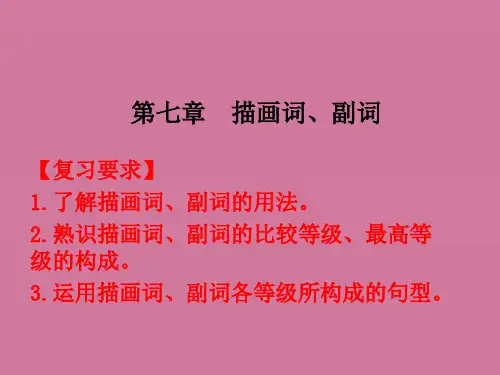- 1、下载文档前请自行甄别文档内容的完整性,平台不提供额外的编辑、内容补充、找答案等附加服务。
- 2、"仅部分预览"的文档,不可在线预览部分如存在完整性等问题,可反馈申请退款(可完整预览的文档不适用该条件!)。
- 3、如文档侵犯您的权益,请联系客服反馈,我们会尽快为您处理(人工客服工作时间:9:00-18:30)。
nice nicer nicest large larger largest
13
以一个辅音字母结 尾的重读闭音节词, big 双写结尾的辅音字 thin 母, 再加-er, -est
bigger biggest thinner thinnest
以辅音字母加y结 尾的双音节词, 变y 为i, 再加-er, -est
important
busy angrier angriest
少数以-er, -ow结尾 的双音节词末尾加
-er, -est
clever narrow
cleverer cleverest narrower narrowest
部分双音节词和多 音节词, 在其前加 more, most来构成 比较级和最高级
9. 形容词词干+名词-ed, 如: kind-hearted 好心的
10. 形容词词干+现在分词, 如: ordinary-looking 相貌一般的
11. 形容词词干+形容词, 如: red-hot 炽热 的
10
四、副词 1. 派生副词 1) 最常用的后缀是-ly, 即“形容词+后缀ly”
构成副词。 2) 还有加后缀-ward(s), -ways, -wise等构成
12
一、形容词和副词比较等级的构成 1. 形容词的比较级和最高级
单音节词和少数双音节词, 一般在词尾加-er, -est 来构成比较级和最高级。
构成法
单音节词和少数双音 节词一般在词尾加-er, -est
以不发音的e结尾的单 音节词只加-r, -st
原级 比较级 最高级
tall taller tallest cheap cheaper cheapest
alive “活着的”; alone “单独的”; ashamed “羞愧的”; asleep “睡着的”; awake “醒着的”等。
5
① 这类形容词除afraid和ashamed可用very修饰 外, 一般不用very修饰, 可用其他表程度的副 词修饰, 如very much。常用搭配: wide awake 完全清醒 sound/fast asleep 酣睡 quite alone 非常孤独 still alive 仍然活着 much alike 非常相似
耗时的 4. 名词词干+形容词, 如: world-famous 世界
闻名的 5. 数词词干+名词, 如: five-star 五星级的 6. 数词词干+名词-ed, 如: three-legged 三条
腿的
9
7. 数词词干+名词+形容词, 如: five-year-old 5岁的
8. 形容词词干+过去分词, 如: ready-made 现成的
full/well/quite aware of 充分意识到; 对……非常清醒 ② 表语形容词还可用作后置定语。如:
He is the most famous scientist alive in the
world today. 6
2. 某些与健康状况有关的形容词: well “健 康的”; fine “健康的”; poorly “不适; 不 舒服”; unwell “不舒服的”; ill “有病 的”; faint “头晕的”等。如: I’m feeling well today. He is ill today.
7
3. 某些描述感觉或心情的形容词: glad “高兴 的”; pleased “高兴的”; content “满意 的”; sorry “难过的”; upset “难过的”等。 如:
I am glad/pleased to hear that you are
offered a good job. 4. 其他表语形容词: certain “确认的”; sure
副词。如: backwards, northwards, sideways, crossways, clockwise等。
11
2. 复合副词和短语副词 复合副词是指由两个词共同组成的副词。 如anyhow, meantime, nowhere, somehow, therefore等。 短语副词是指用连词把副词连接起来的短 语。如back and forth(前后), here and there(到处), now and then(不时)等。
1
2
一、形容词作补语和状语 1. 形容词作主语补足语和宾语补足语时,
可以 表示“现状, 状态”; 也可以表示 某一动作的结果, 常用在表示“认为, 看待”等动词后, 如believe, prove, consider等。
3
2. 形容词作状语时, 可以看作是“being+形 容词”结构或when, if, because等从句的 省略, 表示时间、方式、原因、伴随、让 步、条件等, 也可以表示对主语进行解释, 说明主语是什么情况, 或进行强调, 其逻 辑主语必须与句子主语保持一致。如: Hungry and tired, he had to stop working. Ripe(=When they are ripe), the oranges taste sweet.
4
二、表语形容词 表语形容词是一般只用于系动词后作表语 的形容词, 这类动词常见的有remain, stay,
stand, keep, lie, grow, turn, get, become, run,
come, seem, sound, appear, look, smell, taste, feel等。常见的表语形容词有: 1. 某些以a-开头的形容词: afraid “害怕的”;
“确信的”; fond “喜欢的”; ready “准备好 的”; unable “不能……的”等。如:
I’m certain/sure that he will succeed. 8
三、复合形容词 1. 副词词干+分词, 如: hard-working 勤劳的 2. 名词词干+过去分词, 如: man-made人造的 3. 名词词干+现在分词, 如: time-consuming









